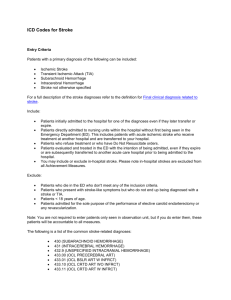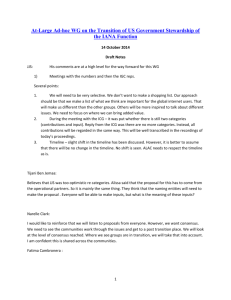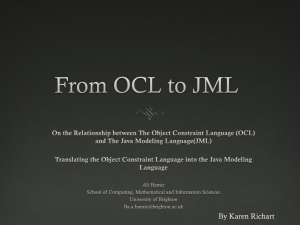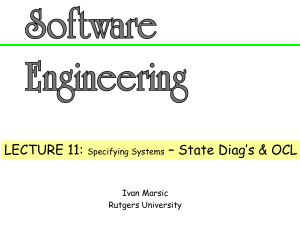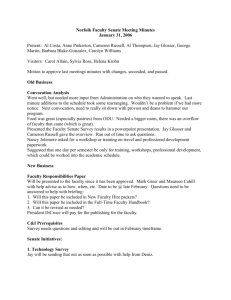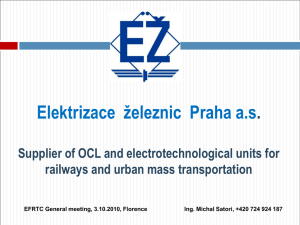Constraints Modeling in Agricultural Databases
advertisement
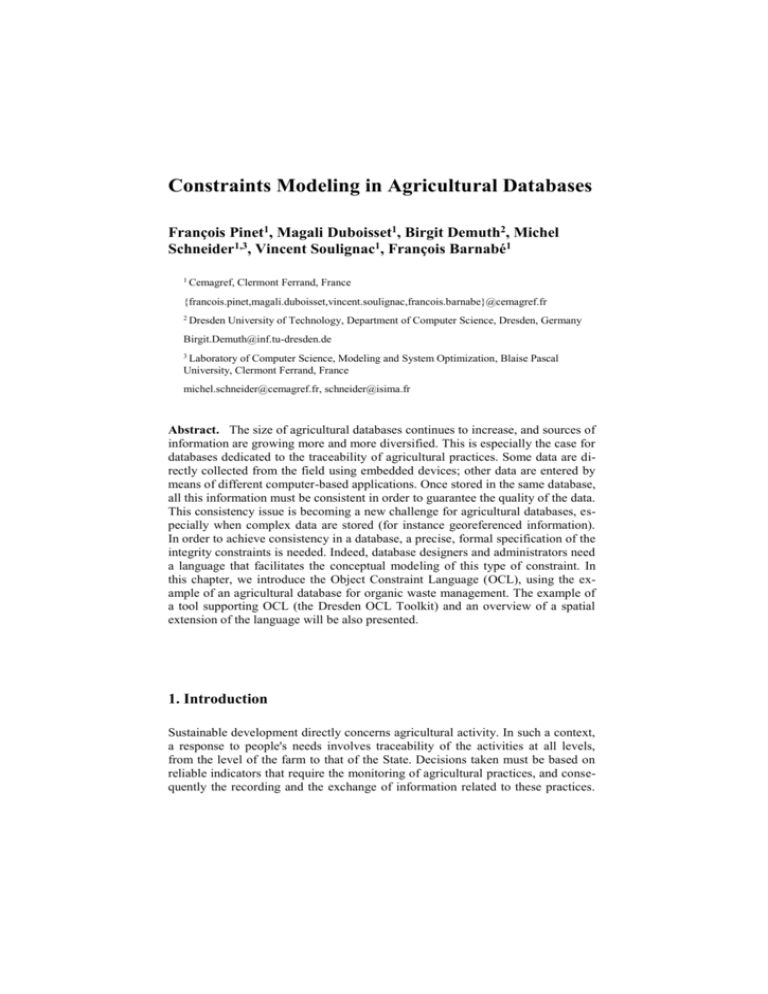
Constraints Modeling in Agricultural Databases
François Pinet1, Magali Duboisset1, Birgit Demuth2, Michel
Schneider1,3, Vincent Soulignac1, François Barnabé1
1
Cemagref, Clermont Ferrand, France
{francois.pinet,magali.duboisset,vincent.soulignac,francois.barnabe}@cemagref.fr
2
Dresden University of Technology, Department of Computer Science, Dresden, Germany
Birgit.Demuth@inf.tu-dresden.de
3
Laboratory of Computer Science, Modeling and System Optimization, Blaise Pascal
University, Clermont Ferrand, France
michel.schneider@cemagref.fr, schneider@isima.fr
Abstract. The size of agricultural databases continues to increase, and sources of
information are growing more and more diversified. This is especially the case for
databases dedicated to the traceability of agricultural practices. Some data are directly collected from the field using embedded devices; other data are entered by
means of different computer-based applications. Once stored in the same database,
all this information must be consistent in order to guarantee the quality of the data.
This consistency issue is becoming a new challenge for agricultural databases, especially when complex data are stored (for instance georeferenced information).
In order to achieve consistency in a database, a precise, formal specification of the
integrity constraints is needed. Indeed, database designers and administrators need
a language that facilitates the conceptual modeling of this type of constraint. In
this chapter, we introduce the Object Constraint Language (OCL), using the example of an agricultural database for organic waste management. The example of
a tool supporting OCL (the Dresden OCL Toolkit) and an overview of a spatial
extension of the language will be also presented.
1. Introduction
Sustainable development directly concerns agricultural activity. In such a context,
a response to people's needs involves traceability of the activities at all levels,
from the level of the farm to that of the State. Decisions taken must be based on
reliable indicators that require the monitoring of agricultural practices, and consequently the recording and the exchange of information related to these practices.
2
To achieve this goal, ever larger environmental and agricultural databases will be
developed.
Often certain data may be directly collected from the field using an embedded device; other data may be imported from other databases or entered by means of different computer-based applications. Once stored in the same database, all this information must be consistent, i.e. all the data must satisfy rules defined by experts;
for instance, organic waste cannot be spread in a lake. Respecting these rules helps
to guarantee the quality of data. By checking these rules, only consistent information will be stored in the database.
The insertion of inconsistent data may lead to the production of inaccurate environmental indicators. Integrity constraints are well-know techniques to guarantee
the consistency of the data. According to [14], integrity constraints are logical
formulae that are dependent on a problem domain, and they must be held to be
true for all meaningful states of information systems. The modeling of integrity
constraints in a conceptual data model may be viewed as a representation of a set
of business rules for the information system. In the context of environmental and
agricultural databases, the satisfaction of these constraints will tend to guarantee
the consistency and quality of data, and consequently the production of reliable
indicators.
The work of [4][5] proposes to make use of the Object Constraint Language
(OCL) [15] to model database integrity constraints. The goal of this chapter is to
introduce the basic concepts of this language by modeling the integrity constraints
of an agricultural database for organic waste management. An example of a tool
supporting OCL (the Dresden OCL Toolkit [2][3]) and an overview of a spatial
extension of the language will be also presented.
2. The Object Constraint Language
The Object Constraint Language provides a standard to define constraints based
on a UML model formally and with precision. OCL is textual and integrates several concepts that come from traditional object-oriented languages. In the context of
databases, an important advantage of OCL is due the fact that constraints are expressed at a conceptual level. OCL is used to specify invariants i.e. conditions that
"must be true for all instances of a class at any time" [20].
OCL was first developed by a group of scientists at IBM around 1995 during a
business modeling project. It was influenced by Syntropy, an object-oriented
modeling language that relies to a large extent on mathematical concepts [1]. OCL
is now part of the UML standard supported by the Object Management Group, and
its role is important in the Model Driven Architecture approach [12]. A growing
number of system designers use this constraint language as a complement to their
class diagram models. OCL is suitable for information system engineers, and is
especially dedicated to formal constraint specification without side effects.
This section illustrates OCL by examples based on the spreading information system described in [21]. This system has been developed to monitor and analyze the
3
spreading of organic wastes on agricultural land in France. A main functionality of
the tool allows users to define the planning of the agricultural spreading. The different types of wastes permitted on each agricultural area can be specified and
stored in a database (see Figure 1).
Figure 1. Different types of wastes permitted on each agricultural area can be specified and
stored in a database
4
Allowed_Parcel
id
status
surface_area
available_surface_area
creation_date
validity_date
geometry
Allowed_SubPart
1
0..*
+subparcels
+parcel
id
surface_area
geometry
0..*
0..*
1
+allowed_area
0..*
+analysed_area
+land
+allowed_organic_waste
Organic _Waste
id
name
capacity
type
end_date_of_use
Soil_Analysis
id
results
geometry
Figure 2. Part of the database conceptual schema (represented in UML)
Allowed Parcel
AP1 and AP2:
global areas on
which the
regulation
allows the
spreading of
organic wastes
AS1
subpart on which the
spreading of the followings
organics wastes may be
carried out:
- sludges of the wastewater
treatment plants A and B
- the organic wastes of the
farm C
AS2
subpart on which
the spreading of
the organic wastes
of the farm C may
be carried out
Allowed
Subparts AS1
and AS2: More
precisely, for
each subpart, a
specific list of
the allowed
organic wastes
can be defined.
Figure 3. Spatial example
Figure 2 presents a small part of the database model of the information system. In
Figure 2, the Allowed_Parcel class models the area on which the regulation
allows the agricultural spreading of organic wastes. Each allowed parcel can be
5
broken down into several subparts (Allowed_Subpart class); for each subpart,
a specific list of organic wastes can be defined (see example of Figure 3). This list
corresponds to an enumeration of all the types of materials (Organic_Waste
class) that can be spread inside the subpart. The relationship between the subparts
and the organic wastes is represented in Figure 1 by the association "land …
allowed_organic_waste". Soil analyses are also carried out. An object diagram corresponding to Figure 3 is presented in Figure 4.
sludges_of_plant_A:Organic_Waste
AP1:Allowed_Parcel
AS1:Allowed_Subpart
sludges_of_plant_B:Organic_Waste
AP2:Allowed_Parcel
AS2:Allowed_Subpart
wastes_of_farm_C:Organic_Waste
Figure 4. Object diagram
In the following OCL constraints, self represents an instance of a class. This
class is specified in "context". The constraints define a condition that must be
true for each instance of the class i.e. for each value of self. The following constraints are based on the UML model presented in Figure 1.
Example 1. The constraint "the surface area of an allowed parcel should be greater than zero" is represented in OCL as follows:
context Allowed_Parcel inv:
self.surface_area > 0
In the constraint definition, self represents an instance of the "context" i.e. an allowed parcel. Thus the constraint defines a condition that must be true for each instance of Allowed_Parcel; self.surface_area is an attribute of self.
Example 2. In practice, for each allowed parcel, the surface area available for
spreading is not necessarily exactly equal to the total surface area. The following
OCL constraint expresses that the total surface area of an allowed parcel should be
greater or equal to its surface area available for spreading.
context Allowed_Parcel inv:
self.surface_area >= self.available_surface_area
In the previous constraint definition, self represents an allowed parcel;
self.surface_area and self.available_surface_area are attributes of self.
6
More complex constraints can be built by using navigations along the associations
between classes. Starting from an object, we can navigate through an association
to refer to other objects and their attributes. The next constraint illustrates the use
of this technique in OCL; it presents a navigation through the "subparcels …
parcel" association, starting from allowed subpart objects to allowed parcel objects.
Example 3. The surface area of an allowed subpart should be lower or equal to
that of the associated allowed parcel.
context Allowed_Subpart inv:
self.surface_area <= self.parcel.surface_area
For instance, the surface areas of AS1 or AS2 should be lower than or equal to the
surface area of AP1 in Figure 4. A complete expression in natural language of the
constraint of Example 3 is: "the surface area of an allowed subpart self is lower
or equal to the surface area of the allowed parcel of self".
By navigating from the class Allowed_Subpart to the class
Allowed_Parcel, the expression self.parcel returns the allowed parcel
linked with the subpart self by the "subparcels … parcel" association.
The expression self.parcel.surface_area returns the surface area of the
allowed parcel.
Universal and existential quantifiers are denoted in OCL by forAll and
exists. These operations are used on collections of objects. The logical implication can be expressed by implies. The next expression exemplifies the operations implies and forAll.
Example 4. An organic waste should not be associated to a new allowed parcel if
the end date of use of the organic material has expired.
context Organic_Waste inv:
self.land->forAll (as |
( not(self.end_date_of_use = 0) ) implies
self.end_date_of_use
> as.parcel.creation_date )
As presented in this constraint, it is possible to navigate between
Organic_Waste and Allowed_Parcel by using the relationships
"allowed_organic_waste … land" and "subparcels … parcel".
The context class is Organic_Waste and self.land returns the collection of
the allowed subparts associated to the organic waste self. For example, by
starting from the object wastes_of_farm_C (=self), this navigation returns
a collection composed of AS1 and AS2 (see Figure 4). For each allowed subpart
as in this collection, if the end date of use of self has been entered in the
7
database, then this date must be greater than the creation date of the allowed
parcel of as. Note that a numeric representation of dates is used in this example.
OCL provides a platform-independent and generic method to model constraints. It
can be interpreted by code engines/compilers to generate code automatically [11].
For instance, Dresden OCL Toolkit developed by the Technische Universität
Dresden can generate SQL code from OCL constraints [3][4][5]. The produced
code can be used to check if a database verifies the constraints or to forbid inserting data that do not verify a constraint. The next section describes the global architecture of this code engine supporting OCL.
3. Example of a tool supporting OCL: The Dresden OCL
Toolkit
The Dresden OCL Toolkit is a software platform for OCL tool support that is designed for openness and modularity, and is provided as open source. The goal of
the platform is, for one thing, to enable practical experiments with various variants
of OCL tool support, and then, to allow tool builders and users to integrate and
adapt the existing OCL tools into their own environments.
The toolkit has been developed in two versions. The older one supports OCL 1.x.
The more recent version supports OCL 2.0 [15]. The definition of the OCL 2.0
language version was a step from a pure constraint language (as presented in section 2) to a query and constraint language [12]. OCL queries can be used to construct any model expressions just as you can construct any tables using SQL queries. This is helpful in writing model transformations that are needed in the modeldriven software development. The architecture of the Dresden OCL2 Toolkit is
metamodel-based (see Figure 5). This means that all models have a metamodel,
and metamodels are managed as MOF (Meta Object Facility) instances [16].
Figure 5 shows the most used Dresden OCL tools. We divide these tools into three
categories: Base tools, tools working with base tools and end user tools.
The most important base tool is the OCL2 compiler that parses an OCL string and
generates the abstract syntax model (ASM) of the OCL expression. An ASM represents a UML/OCL model or an MOF/OCL metamodel and is stored into the repository. The OCL Base Library provides Java code for all predefined OCL Types
such as Integer and Collection. The Code Generator is an abstraction of multiple
general template engines (such as StringTemplate) helpful for reuse by the Transformation Framework and the OCL Declarative Code Generator.
8
Figure 5. Architecture of the Dresden OCL2 Toolkit
Figure 5 presents the modular structure of the existing tools by dependencies.
Tools working with base tools and end user tools are dependent of base tools. For
example, the UML tool Fujaba4Eclipse integrates our OCL tools, and the OCL
editor Eclipse plug-in calls the OCL2 compiler. The OCL22Java tool generates
Java code out of OCL expressions, and also instruments Java programs with the
generated code.
From the end user point of view there is still another code generator, the
OCL22SQL tool generating SQL code for checking the database which implements the UML model. Strictly speaking, the OCL22SQL tool is an application of
the OCL Declarative Code Generator and the Transformation Framework. Both
tools constitute together a framework to map OCL to declarative languages such
as SQL or XQuery. The OCL Declarative Code Generator provides a language
independent mapping schema, where the declarative target language is described
by templates. Since OCL constraints refer to a UML or MOF model, we need to
transform this source model too, and make it accessible through the declarative
target language. This task undertakes the Transformation Framework which supports both model-to-model and model-to-code transformations. In the OCL22SQL
9
case, the Transformation Framework is used to map a UML model to a relational
(SQL) database schema.
The underlying idea of both SQL code generators is described in [4]. Though SQL
specification provides powerful language concepts (such as assertions and triggers) to enforce integrity by the database management system (DBMS), current
DBMSs implement them only at the entry or intermediate level [13][22]. The
OCL22SQL code generator supports an application-enforced approach realizing
an independent constraint check. The basic element of our approach is the socalled Integrity Views generated from OCL constraints. The SQL code generated
by OCL22SQL can be used to create these views. The evaluation of these views
provides a set of tuples from the constrained tables that constitutes the objects violating the constraint. For instance, the integrity view generated from the OCL constraint of Example 1 will make it possible to select all parcels that have their attribute surface_area lower or equal to zero.
Currently the architecture of the Dresden OCL Toolkit has been reengineered
again to support any MOF based metamodels and, besides Netbeans MDR, further
repositories such as EMF (the Eclipse Modeling Framework). The repository independence allows for a broader reuse of the Dresden OCL tools, especially by the
large Eclipse community. The support of any metamodels enormously broadens
the application of OCL. Thus, for example, OCL expressions can not only be
specified on UML or MOF models, but also be used for XML and Domain Specific Languages (DSLs).
4. Extending OCL for spatial objects
As environmental events occur in time and space, and often data used by agricultural systems are georeferenced. As an example, the databases developed to monitor and analyze the spreading of organic wastes [21] make considerable use of
georeferenced data. It is very important to model spatial constraints that model the
different spatial configurations of the objects accurately. The purpose of this chapter is to show how it is possible to extend OCL in order to model this type of constraint.
The chapter will present the integration of spatial functions based on Egenhofer's
relationships into OCL. The extended language will be called "Spatial OCL" [6].
The eight Egenhofer binary relationships presented in Figure 6 have been actively
studied [8][9]; they constitute the basis of Oracle Spatial SQL [17].
The general syntax of the proposed OCL spatial functions is:
A.Egenhofer_topological_relation(B) : Boolean
Thus, Egenhofer_topological_relation can be: disjoint, contains,
inside, equal, meet, covers, coveredBy, overlap. A and B are the
parameters of the operations, i.e. the two simple geometries to compare. These
operations return true or false depending on whether the topological relation
between A and B is true or false. Only the relationships between regions are
10
considered in this chapter. The following example of OCL constraint illustrates
the use of the proposed functions.
A
A
B
A, disjoint, B
A
B
A, meet, B
B
A, contains, B
A
A
A
A
B
B
A
A, coveredBy, B
B
A, equal, B
A, inside, B
B
A, covers, B
B
A, overlap, B
Figure 6. 8 Egenhofer's binary relationships between two simple regions
Example 5. An allowed subpart is spatially inside or equal to or covered by its allowed parcel.
context Allowed_Subpart inv:
self.geometry.inside(self.parcel.geometry) or
self.geometry.equal(self.parcel.geometry) or
self.geometry.coveredBy(self.parcel.geometry)
For instance, in Figure 4, AS1 and AS2 are covered by AP1.
Example 6. All allowed subparts of the same allowed parcels should be disconnected or should meet each other.
context Allowed_Subpart inv:
Allowed_Subpart.allInstances()->forAll( as |
( not(self.id = as.id) and
self.parcel.id = as.parcel.id )
implies self.geometry.disjoint(as.geometry) or
self.geometry.meet(self.geometry) )
In OCL, C.allInstances()is an operation returning a collection containing
all the instances of a class C. Thus, the constraint of the example means that if two
distinct allowed subparts as and self have the same allowed parcel then they
should be disconnected or they should meet each other.
11
In order to provide checking mechanisms from spatial constraints, Cemagref implemented the functions presented in this section into a specific extension of the
old version of the Dresden OCL22SQL code generator (developed by the Technische Universität Dresden) [19]. This extension has been used to produce Oracle
Spatial SQL code automatically from spatial constraints. This code has been generated and has been used to check the consistency of agricultural data.
5. Conclusion
OCL is a standard and conceptual language [15]. It is used in the model driven
software development to describe the behavior of an object formally and to generate the corresponding code automatically [12]. Furthermore, OCL integrates notations close to a spoken language to express constraints.
OCL provides a platform-independent and generic method to model constraints.
As presented in section 3, it can be interpreted by code engines/compilers to generate code automatically. Indeed, some tools allow for the production of integrity
checking mechanisms in different languages from specifications of constraints expressed in OCL [3][11].
In database management systems, OCL can be used to model integrity constraints.
OCL provides a formal language to define these constraints precisely. In the context of environmental and agricultural databases, the satisfaction of these constraints will tend to guarantee the consistency and the quality of data, and consequently the production of reliable indicators.
Concerning the modeling of spatial constraints, several recent papers deal with the
spatial extensions of OCL [6][7][10][18][19]. The proposed languages could be
viewed as DSLs (Domain Specific Languages) [2].
References
1. Cook, S., Daniels, J.: Designing Object Systems-Object Oriented Modeling with Syntropy.
Prentice-Hall: New York (1994)
2. Demuth, B.: The Dresden OCL Toolkit and the Business Rules Approach. European Business
Rules Conference (EBRC2005), Amsterdam, <http://st.inf.tudresden.de/files/papers/EBRC2005_Demuth.pdf> (2005)
3. Demuth, B., Loecher, S., Zschaler, S.: Structure of the Dresden OCL Toolkit. In: 2nd International Fujaba Days “MDA with UML and Rule-based Object Manipulation”. Darmstadt,
Germany, September 15 - 17 (2004)
4. Demuth, B., Hußmann, H., Loecher, S.: OCL as a Specification Language for Business Rules
in Database Applications. Lecture Notes in Computer Science vol. 2185, 104-117, Springer
(2001)
5. Demuth, B., Hußmann, H.: Using UML/OCL Constraints for Relational Database Design.
Lecture Notes in Computer Science vol. 1723, 598-613, Springer (1999)
12
6. Duboisset, M, Pinet, F., Kang, M.A., Schneider, M.: Precise Modeling and Verification of
Topological Integrity Constraints in Spatial Databases: From an Expressive Power Study to
Code Generation Principles. Lecture Notes in Computer Science vol. 3716, 465-482, Springer (2005).
7. Duboisset, M., Pinet,F., Kang, M.A., Schneider, M.: Integrating the Calculus-Based Method
into OCL: Study of Expressiveness and Code Generation. DEXA Workshops, 502-506
(2005)
8. Egenhofer, M., Franzosa, R.: Point-Set Topological Spatial Relations. International Journal of
Geographical Information Systems 5 (2) 161-174 (1991)
9. Egenhofer, M., Herring, J.: Categorizing Binary Topological Relationships between Regions,
Lines, and Points in Geographic Databases. Technical report. Department of Surveying Engineering, University of Maine, Orono, ME, 28p. (1992)
10. Hasenohr, P., Pinet, F.: Modeling of a Spatial DSS Template in Support to the Common Agricultural Policy. Journal of Decision Systems 15 (2) 181-196 (2006)
11. Klasse Objecten: OCL Tools and Services Web site, <http://www.klasse.nl/ocl> (2005)
12. Kleppe, A., Warmer, J.: Object Constraint Language, the Getting your Models Ready for
MDA, Addison-Wesley (2003).
13. Melton, J, Simon, A.: Understanding the New SQL: A Complete Guide. Morgan Kaufmann
(1993)
14. Miliauskaitė, E., Nemuraitė., L.: Representation of Integrity Constraints in Conceptual Models. Information Technology and Control, vol. 34 (4) 355-365 (2005)
15. OMG: OCL 2.0 specification.: OMG specification, 185p. (2005)
16. OMG: OMG MOF Web site, <http://www.omg.org/mof > (2007)
17. Oracle Corp.: Oracle Spatial. User’s Guide and Reference. Oracle documentation (2005)
18. Pinet, F., Kang, M.A., Vigier, F.: Spatial Constraint Modelling with a GIS Extension of
UML and OCL: Application to Agricultural Information Systems. Lecture Notes in Computer
Science vol. 3511 160-178 (2005)
19. Pinet, F., Duboisset, M., Soulignac, V.: Using UML and OCL to Maintain the Consistency of
Spatial Data in Environmental Information Systems. Environmental Modelling and Software,
vol. 22 (8) 1217-1220 (2007)
20. Schmid, B., Warmer, J., Clark, T.: Object Modeling with the OCL: The Rationale Behind the
Object Constraint Language, Springer, 281p, (2002)
21. Soulignac, V., Gibold, F., Pinet, F., Vigier, F.: Spreading Matter Management in France
within Sigemo. In: Proceedings of the 5th European conference For Information Technologies in Agriculture (EFITA 2005), Vila Real, Portugal, July 25-28, 8p. (2005)
22. Türker, C., Gertz, M.: Semantic Integrity Support in SQL:1999 and Commercial (Object-)
Relational Database Management Systems. The VLDB Journal vol. 10 (4) 241-269 (2001)

